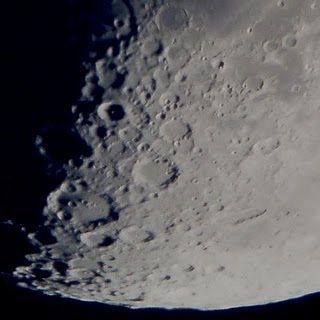THE LUNAR TERMINATOR
Posted by: admin on: July 16, 2011
Today we write an explanation of the meaning of “lunar terminator”. I searched the internet and not fully satisfied me anything I found. So I accepted the challenge to explain it myself, with some graphic support, to help understand it better.
It is well known that the moon, the beautiful heavenly body that serves us as companion day and night, though many think it is only at night, as I say that everyone knows has phases. This means that the surface that shows illuminated by the Sun, because that is the source of its brilliance, is changing every day, even every moment, showing almost always (except full moon) one portion illuminated and another dark separated by a line that marks the division between selenite day and night: The lunar terminator. This line, of course, is constantly changing its location, and it is where the sunlight is flush and an observer on the moon’s surface at that point would see the sun on the horizon. The terminator has two ends, north and south, called cusps.
It  is important to notice, and it can be seen in the photograph, how it is along the terminator where we can see the shadows reveal the depth of the crater walls and the height of the mountain ranges. Looking at the Northern Hemisphere, we see a crater, just above the terminator, which is the large crater Plato (101 km in diameter and walls 2400 meters high) below Archimedes (55 km and 1850 m), almost in darkness and then a mountain range, almost straight, near the landing site of Apollo XV, which is called Montes Apenninus, in memory of its namesake mountain range in Italy. This ends, at its western end, in the crater Eratosthenes (60 km and 3150 m), a resident of the great Copernicus (90 km and 3900 m), “The Lord of the Moon” with its radial system of ejecta at the time impact. Well, we see how Copernicus receives sunlight more perpendicular than the other craters near the terminator, and we cannot appreciate it’s depth, though it exceeds the highest point in Spain, Mount Teide in Tenerife (3718 m above sea level).
is important to notice, and it can be seen in the photograph, how it is along the terminator where we can see the shadows reveal the depth of the crater walls and the height of the mountain ranges. Looking at the Northern Hemisphere, we see a crater, just above the terminator, which is the large crater Plato (101 km in diameter and walls 2400 meters high) below Archimedes (55 km and 1850 m), almost in darkness and then a mountain range, almost straight, near the landing site of Apollo XV, which is called Montes Apenninus, in memory of its namesake mountain range in Italy. This ends, at its western end, in the crater Eratosthenes (60 km and 3150 m), a resident of the great Copernicus (90 km and 3900 m), “The Lord of the Moon” with its radial system of ejecta at the time impact. Well, we see how Copernicus receives sunlight more perpendicular than the other craters near the terminator, and we cannot appreciate it’s depth, though it exceeds the highest point in Spain, Mount Teide in Tenerife (3718 m above sea level).
The rest of the illuminated surface on the moon, further from our line, it seems to us almost flat, without being, because of the effect described in the perpendicularity of the sun and the absence of shadows.
It is easily understood that when the moon is fully illuminated (the full moon phase), there is no terminator, and we can not take advantage of this inclination of the sun for optimal observation. That’s why astronomers, against the belief of the majority, avoid this stage that only poses problems to the observer. When studying deep-sky objects, the full moon works as a huge spotlight installed in the sky that dazzles and prevents the vision of lower luminosity objects such as star clusters, nebulae and distant galaxies. If we want to study the moon, the perpendicularity of the rays also greatly complicates the study, revealing even necessary to use a moon filter (a light green or yellow would be appropriate) to avoid damage to our eyes producing a prolonged observation (The reflecting light of the full moon is 12 times higher than it radiates at waxing or waning crescent).
I know amateurs who keep their astronomical equipment in such situations and use them again only when the moon decreases the intensity of its brightness. Definitely, these guys aren’t werewolves nor are in love, because they really do appreciate the full moon.
A couple of definitions alien to me:
WIKIPEDIA: The Lunar terminator is the division between the illuminated and dark parts of the Earth’s Moon.
Elcielodelmes.com: The area bordering the light and shadow is called the terminator.
One last example to end:

South Moon photography, one of the most rugged. Being close to the terminator, the craters can be seen in all its splendor.
Anyway, that’s all. I did not want to do a superficial, long and tedious outline with excessive technical details, less interesting, nor a walk too shallow not to allow to understand the meaning and importance of the lunar terminator, that ally helping us in contemplation, study and enjoy of our beautiful satellite. I hope this small contribution is helpful.
May you have clear skies and happy observations.

Leave a Reply